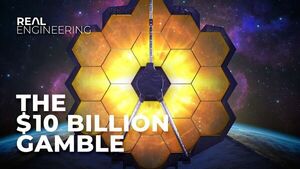2021-12-23 - Nº 347
Editorial
Esta é a Newsletter Nº 347 que se apresenta com o mesmo formato que as anteriores. Se gostar da Newsletter partilhe-a!
Todas as Newsletters encontram-se indexadas no link.
Esta Newsletter tem os seguintes tópicos:
Faz hoje anos que nascia, em 1722, o químico e metalúrgico sueco Axel Fredrik Cronstedt. Ele foi o primeiro a isolar o níquel (1751) e a notar as suas ligeiras propriedades magnéticas. Uma nova classificação química de minerais que ele fez foi traduzida para várias línguas. Os padrões que encontrou na estrutura interna dos minerais permitiram-lhe distinguir entre os minerais simples de um só componente e os compostos por uma mistura de vários minerais. Descobriu o zeólito, um silicato suavizante da água e analisou o tungstato mineral de cálcio de alta densidade. Através da utilização hábil do maçarico para intensificar uma chama e queimar uma pequena quantidade de um mineral, pôde fazer uma identificação da sua composição química com base na cor da chama. Ele não inventou o instrumento, mas fundou uma técnica de análise sistemática do maçarico.
Faz também hoje anos que nascia, em 1732, o industrial e inventor inglês Richard Arkwright. Ele introduziu métodos de produção de fábricas têxteis mecanizados e motorizados que foi muito bem sucedida. A máquina Spinning-Frame que ele inventou (1769, patente britânica nº 931) para fiar fio de algodão utilizava múltiplos conjuntos de rolos emparelhados que giravam a diferentes velocidades capazes de extrair fio com a espessura correcta, e um conjunto de fusos para torcer as fibras firmemente juntas. Produziu um fio muito mais forte do que o fio feito pela Spinning-Jenny de James Hargreaves. A máquina de Arkwright era demasiado grande para ser accionada manualmente, por isso ele alimentou-a com uma roda de água (1771) quando ficou conhecida como a Moldura de Água. O negócio têxtil de Arkwright expandiu-se, ele construiu mais fábricas, e mais tarde adoptou a força do vapor.
Faz igualmente hoje anos que nascia, em 1766, o mineralogista sueco Wilhelm Hisinger. Ele herdou o trabalho em ferro do seu pai, e prosseguiu a ciência em privado. De uma das suas minas de ferro em Bastnäs veio um mineral de densidade invulgarmente elevada. Hisinger distribuiu amostras a vários analistas químicos europeus. Após o seu exame em 1803, Martin Klaproth suspeitou que o mesmo continha um novo elemento. Nesse ano, tanto Hisinger como Jöns Berzelius isolaram o novo elemento. Deram-lhe o nome de cerium em reconhecimento da descoberta de Giussepe Piazzi da nova planta menor, Ceres, dois anos antes (1 de Janeiro de 1801). Em 1806, Hisinger investigou o efeito da electricidade nas soluções salinas. Ele contribuiu para o conhecimento geológico do seu país, e registou descobertas dos seus fósseis de animais e plantas. Também acumulou colecções de rochas finas, minerais e fósseis, que acabou por dar ao museu de história natural sueco.
Faz também hoje anos que nascia, em 1822, o inventor alemão Wilhelm Bauer. Ele foi um pioneiro dos submarinos. A 1 de Fevereiro de 1851, no porto de Kiel, fez uma prova de mergulho no seu primeiro submarino, Le Plongeur-Marin ("O Mergulhador Marinho"), apenas para afundar a 50 pés devido a fugas de água no casco. Sobreviveu esperando que a pressão do ar interior, comprimida à medida que mais água vazava para dentro, igualasse a pressão da água no exterior. Sete horas mais tarde, ele e a sua tripulação abriram a escotilha e subiram à superfície para encontrar serviços funerários em curso. Em 1855, Bauer construiu um submarino de ferro de 52 pés, de quatro homens, Le Diable-Marin ("O Diabo Marinho") com 11 tripulantes. As fotografias que Bauer fez através das suas janelas são provavelmente as primeiras tiradas debaixo de água. Ele também experimentou a purificação do ar e sinais sonoros subaquáticos.
Por fim, faz hoje anos que nascia, em 1938, o cientista informático norte-americano Bob Kahn. Ele co-criou os protocolos de comutação de pacotes que permitem aos computadores trocar informações na Internet. No final dos anos 60, Kahn percebeu que uma rede de comutação de pacotes podia efectivamente transmitir grandes quantidades de dados entre computadores. Juntamente com colegas cientistas informáticos Vinton Cerf, Lawrence Roberts, Paul Baran, e Leonard Kleinrock, Kahn construiu a ARPANET, a primeira rede a ligar com sucesso computadores em todo o país. Kahn e Cerf também desenvolveram o Protocolo de Controlo de Transmissão (TCP) e o Protocolo Internet (IP), que juntos permitem a comunicação entre diferentes tipos de computadores e redes; o TCP/IP é o padrão ainda hoje em uso. É graças aos contributos de Kahn que é possível neste momento ler esta newsletter!
Após nove dias e quatro minutos no céu, o avião experimental Voyager aterrava na Base Aérea Edwards na Califórnia, completando o primeiro voo ininterrupto à volta do globo com uma única carga de combustível. Pilotada pelos americanos Dick Rutan e Jeana Yeager, a Voyager foi feita principalmente de plástico e papel reforçado e transportou mais de três vezes o seu peso em combustível quando descolou da Base da Força Aérea de Edwards a 14 de Dezembro. Quando regressou, depois de voar 25.012 milhas à volta do planeta, já tinha apenas cinco galões de combustível no seu restante tanque de combustível operacional. Estávamos no ano de 1986.
Em 23 de Dezembro de 1672, o astrónomo italiano Giovanni Cassini descobriu Rhea, a segunda maior lua de Saturno. Rea é feita de rocha e gelo e está coberta de crateras. Rhea é também a única lua descoberta a ter uma atmosfera de oxigénio. Rea foi a segunda lua que Cassini descobriu. Ele descobriu a lua de Saturno Iapetus cerca de um ano antes.
Nesta semana que passou e após mais de duas décadas de desenvolvimento, o telescópio espacial de próxima geração da NASA está na plataforma de lançamento. O Telescópio Espacial James Webb deverá ser lançado no sábado (25 de Dezembro) durante uma janela de 32 minutos que abre às 7:20 EST (1220 GMT). O enorme observatório será lançado de Kourou, Guiana Francesa, sobre um foguete Ariane 5 operado pelo fornecedor europeu de lançamento Arianespace.
Na Newsletter desta semana apresentamos diversas noticias, artigos científicos, projetos de maker assim como alguns vídeos interessantes. É apresentada a revista HackspaceMag nº 50 de Janeiro. Aproveito para desejar a todos votos de Boas Festas.
 João Alves ([email protected])
João Alves ([email protected])
O conteúdo da Newsletter encontra-se sob a licença  Creative Commons Attribution-NonCommercial-ShareAlike 4.0 International License.
Creative Commons Attribution-NonCommercial-ShareAlike 4.0 International License.
Novidades da Semana
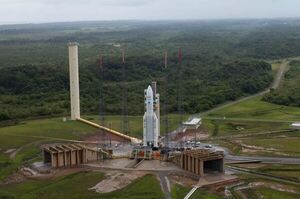
James Webb Space Telescope reaches launch pad for Christmas liftoff
"After more than two decades of development, NASA's next-generation space telescope is on the launch pad. The James Webb Space Telescope is due to launch on Saturday (Dec. 25) during a 32-minute window that opens at 7:20 a.m. EST (1220 GMT). The massive observatory will blast off from Kourou, French Guiana, atop an Ariane 5 rocket operated by European launch provider Arianespace. You can watch launch coverage live at Space.com beginning at 6 a.m. EST (1100 GMT) courtesy of NASA or you can watch directly at the agency's website. The Ariane 5 topped by the long-awaited space telescope rolled out from Arianespace's final assembly building at about 11 a.m. EST (1600 GMT), according to a NASA tweet. The rocket had arrived by 1 p.m. EST (1800 GMT), according to the agency." [...]
Outras Notícias
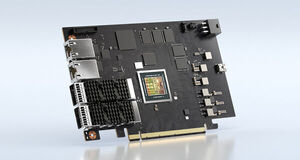
NVIDIA BlueField Sets New World Record for DPU Performance
"Data processing unit more than quadruples previous record holder by exceeding 41 million IOPS between server and storage. Data centers need extremely fast storage access, and no DPU is faster than NVIDIA’s BlueField-2. Recent testing by NVIDIA shows that two BlueField-2 data processing units reached 41.5 million input/output operations per second (IOPS) — more than 4x more IOPS than any other DPU. The BlueField-2 DPU delivered record-breaking performance using standard networking protocols and open-source software. It reached more than 5 million 4KB IOPS and from 7 million to over 20 million 512B IOPS for NVMe over Fabrics (NVMe-oF), a common method of accessing storage media, with TCP networking, one of the primary internet protocols. To accelerate AI, big data and high performance computing applications, BlueField provides even higher storage performance using the popular RoCE network transport option." [...]

Toshiba’s Transparent Cu2O Tandem Solar Top Cell Achieves 8.4% Efficiency
"A boost to development of no-plug charging EVs and transition to renewable energy. Toshiba Corporation (TOKYO: 6502) today announced that it has successfully raised the power conversion efficiency (PCE) of its transparent Cu2O solar cell to 8.4%, the world’s highest level for a reported Cu2O solar cell(*1). With the cell positioned as the top cell over a 25% PCE silicon cell (Cu2O-Si tandem cell), Toshiba estimates that an overall PCE of 27.4% can be achieved, notably above the 26.7% highest PCE reported for any standard silicon cell(*2). Under the test criteria defined by Japan’s New Energy and Industry Technology Development Organization (NEDO), Toshiba estimates that the Cu2O-Si tandem cell will carry an EV 35km without any need of recharging. Looking ahead, Toshiba expects the new cell to boost development of EVs with no need for plug-in charging, and to advance other mobility applications, such as the High Altitude Platform Station (HAPS), the telecom platform in the stratosphere. " [...]

Samsung Develops High-Performance PCIe 5.0 SSD for Enterprise Servers
"Samsung’s PCIe 5.0 SSD will provide nearly two times faster data transfer speeds and 30% enhanced power efficiency than the previous generation, resulting in lower server operating costs* Undergoing joint evaluations with chipset and server manufacturers to drive the transition to the PCIe 5.0 interface in next-generation servers Samsung Electronics, the world leader in advanced memory technology, today announced that it has developed the PM1743 SSD for enterprise servers, integrating the PCIe (Peripheral Component Interconnect Express) 5.0 interface with Samsung’s advanced sixth-generation V-NAND. “For over a decade, Samsung has been delivering SATA, SAS and PCIe-based SSDs that have been recognized for outstanding performance and reliability by leading enterprise server customers including corporations, governments and financial institutions,” said Yong Ho Song, Executive Vice President and Head of the Memory Controller Development Team at Samsung Electronics. “The introduction of our PCIe 5.0 SSD, along with PCIe 6.0-based product developments that are underway, will further solidify our technological leadership in the enterprise server market.” “Intel has been working with Samsung to test Samsung’s newest PCIe NVMe SSD, the PM1743. Together, we have jointly resolved complicated technical issues encountered with PCIe 5.0 during this initial evaluation period. The performance potential of Gen5 is truly impressive. In the near future, we strongly believe that PCIe Gen5 systems with high-speed NVMe SSDs will have the ability to transform applications such as AI/ML and high-performance databases,” said Jim Pappas, Director, Technology Initiatives, Intel Corporation." [...]

NASA’s Juno Spacecraft ‘Hears’ Jupiter’s Moon
"An audio track collected during Jupiter mission’s Ganymede flyby offers a dramatic ride-along. It is one of the highlights mission scientists shared in a briefing at American Geophysical Union Fall Meeting. Sounds from a Ganymede flyby, magnetic fields, and remarkable comparisons between Jupiter and Earth’s oceans and atmospheres were discussed during a briefing today on NASA’s Juno mission to Jupiter at the American Geophysical Union Fall Meeting in New Orleans. Juno Principal Investigator Scott Bolton of the Southwest Research Institute in San Antonio has debuted a 50-second audio track generated from data collected during the mission’s close flyby of the Jovian moon Ganymede on June 7, 2021. Juno’s Waves instrument, which tunes in to electric and magnetic radio waves produced in Jupiter’s magnetosphere, collected the data on those emissions. Their frequency was then shifted into the audio range to make the audio track." [...]

SpaceX lofts Turkish communications satellite to orbit in 2nd Falcon 9 rocket launch of the day
"SpaceX launched its second rocket in less than 24 hours on Saturday night (Dec. 18), delivering a Turkish communications satellite into orbit before capping off the successful mission with a landing at sea. A 230-foot-tall (70 meters) Falcon 9 rocket blasted off from Space Launch Complex 40 here at Cape Canaveral Space Force Station at 10:58 p.m. EST (0358 GMT on Dec. 19), at the beginning of a planned 90-minute window, carrying the Turksat 5B satellite into space. Approximately nine minutes later, the rocket's first stage returned to Earth, touching down on the deck of SpaceX's newest drone ship, "A Shortfall of Gravitas." The ship is one of three massive floating landing pads that the California-based aerospace company uses to recover its rockets. The other two — named "Of Course I Still Love You" and "Just Read the Instructions" — are carrying out missions of their own, marking the first time ever that all three drone ships are deployed at the same time. "Falcon 9 has successfully lifted off from SLC-40 at Cape Canaveral Space Force station carrying a satellite to geosynchronous transfer orbit," SpaceX's principal integration engineer John Insprucker said during a live webcast of the launch." [...]
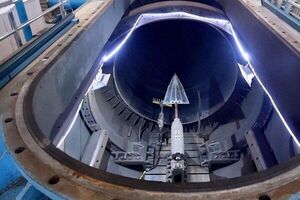
Mach 30 wind tunnel to ‘put China decades’ ahead in hypersonic race
"A Chinese physicist has said that a new wind tunnel in Beijing to be unveiled “soon” will put China decades ahead of the rest of the world in hypersonic technology. Chinese Academy of Sciences researcher Han Guilai told an online lecture last week that the JF-22 wind tunnel, in Beijing’s Huairou district, was capable of simulating flights at up to 10km per second – 30 times the speed of sound. Together with an existing facility, also in Beijing, it would put China “about 20 to 30 years ahead” of the West. Han, from China’s top hypersonic research agency the Institute of Mechanics, said the surface of an aeroplane travelling at such a speed could reach 10,000 degrees Celsius (18,032 Fahrenheit) – hot enough to break air molecules into atoms, even giving some of them an electric charge. “This air is no longer the air we breathe in,” said Han. “The flying vehicle we study is like swimming in mud.” Han said the power produced by the JF-22 wind tunnel would reach 15 gigawatts – nearly 70 per cent of the installed capacity of the world’s largest hydropower station Three Gorges Dam in China’s southwestern Sichuan province, or more than seven times the Hoover Dam in Nevada." [...]

Opening a 50-year-old Christmas present from the Moon
"A pretty special gift unwrapping will soon take place – a piercing tool built by ESA will open a Moon soil container from Apollo 17 that has gone untouched for nearly 50 years. The opening will allow the extraction of precious lunar gases which may have been preserved in the sample. Analysis of the gaseous volatiles will allow scientists to better understand the geology of the Moon and help engineers to design better sampling tools and techniques for future missions to the Moon or even Mars. The gas extraction experiment is part of the larger Apollo Next-Generation Sample Analysis (ANGSA) programme that coordinates the analysis of pristine Moon samples from the Apollo era. And for the first time ever, ESA is involved in the opening of soil returned from the Moon. “The opening and analyses of these samples now, with the technical advancements achieved since the Apollo era, can enable new scientific discoveries on the Moon." [...]
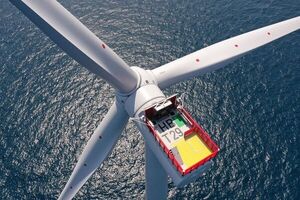
The world’s biggest offshore wind farm, Hornsea 2, generates first power
"When fully operational, Hornsea 2’s 165 8 MW Siemens Gamesa wind turbines will be capable of generating 1.32 GW of clean electricity – taking the title of ‘world’s largest operating offshore wind farm’ from its sibling project Hornsea 1. Together, the two projects will be capable of providing enough power for well over 2.3 million homes. First power on Hornsea 2, which is located 89 km off the UK's east coast, was achieved after its offshore substation (OSS), the world’s largest offshore AC substation, and reactive compensation station (RCS), were installed in late October 2021. Since that time, Ørsted and its partner companies have been working hard to commission and energise the wind farm in preparation for its anticipated operational date next year. Once Hornsea 2 is completed, power will be transferred from the 165 wind turbines via 373 km of array cables to the OSS and RCS, reaching the national grid via 390 km of offshore and 40 km of onshore export cables which terminate at the onshore substation in Killingholme. A further two projects in the Hornsea Zone are also underway with Hornsea 3 receiving a Development Consent Order in December 2020 and Hornsea 4 currently going through the planning process." [...]

How NASA’s Psyche Mission Will Explore an Unexplored World
"Launching in August 2022 and arriving at the asteroid belt in 2026, NASA’s Psyche spacecraft will orbit a world we can barely pinpoint from Earth and have never visited. The target of NASA’s Psyche mission – a metal-rich asteroid, also called Psyche, in the main belt between Mars and Jupiter – is an uncharted world in outer space. From Earth- and space-based telescopes, the asteroid appears as a fuzzy blur. What scientists do know, from radar data, is that it’s shaped somewhat like a potato and that it spins on its side. By analyzing light reflected off the asteroid, scientists hypothesize that asteroid Psyche is unusually rich in metal. One possible explanation is that it formed early in our solar system, either as a core of a planetesimal – a piece of a planet – or as primordial material that never melted." [...]

SpaceX Dragon cargo ship delivers Christmas presents (and supplies) to space station
"A turkey dinner and presents arrived in time for the holidays. A SpaceX Dragon capsule arrived at the International Space Station early Wednesday (Dec. 22), carrying with it a holiday haul of science gear and Christmas treats for the astronauts living on the orbital outpost. The autonomous Dragon resupply ship docked itself at the orbital outpost at 3:41 a.m. EST (0841 GMT), ahead of its planned 4:30 a.m. docking time. It parked itself at the space-facing port on the station's Harmony module, with NASA astronauts Raja Chari and Tom Marshburn monitoring the docking from inside the station. The Dragon capsule blasted off on its cargo mission for NASA, called CRS-24, early Tuesday (Dec. 21) atop a SpaceX Falcon 9 rocket from NASA's Kennedy Space Center in Florida. It delivered 6,500 pounds (2,949 kilograms) of research experiments and supplies for the crew." [...]
Ciência e Tecnologia

Magnetic storage that runs on light
"Researchers at the Department of Physics have carried out projects to make magnetic storage operate with light, making it more energy efficient, smaller, and about 10 000 times faster than what is currently available. Contact Alexander Friemann Dmitriev Professor +46 708-42 38 19 [email protected] “To achieve this, we take the primely efficient light concentrators, optical nanoantennas, and make them channel light to the nanoscale, where we put magnetic materials,” says Alexandre Dmitriev, professor at the Department of Physics. The researchers have tested two related concepts. In one work, the researchers shrink TbCo rare-earth transition-metal alloy magnets, making them nanosized, to in the future be able to switch their magnetisation with femtosecond light pulses. At the same time, they manage to maintain their critical characteristic for switching with light, out-of-plane magnetic anisotropy. They then build arrays of such nanoantennas with magnetic nanoelements, and test how nanoantennas channel light to the ferrimagnets, and how the eventual magnetic state could be read-out." [...]

Technique Tunes Into Graphene Nanoribbons’ Electronic Potential
"Breakthrough could lead to high-speed, low-power nanoscale data storage Ever since graphene – a thin carbon sheet just one-atom thick – was discovered more than 15 years ago, the wonder material became a workhorse in materials science research. From this body of work, other researchers learned that slicing graphene along the edge of its honeycomb lattice creates one-dimensional zigzag graphene strips or nanoribbons with exotic magnetic properties. Many researchers have sought to harness nanoribbons’ unusual magnetic behavior into carbon-based, spintronics devices that enable high-speed, low-power data storage and information processing technologies by encoding data through electron spin instead of charge. But because zigzag nanoribbons are highly reactive, researchers have grappled with how to observe and channel their exotic properties into a real-world device. Now, as reported in the journal Nature, researchers at Lawrence Berkeley National Laboratory (Berkeley Lab) and UC Berkeley have developed a method to stabilize the edges of graphene nanoribbons and directly measure their unique magnetic properties. The team co-led by Felix Fischer and Steven Louie, both faculty scientists in Berkeley Lab’s Materials Sciences Division, found that by substituting some of the carbon atoms along the ribbon’s zigzag edges with nitrogen atoms, they could discretely tune the local electronic structure without disrupting the magnetic properties." [...]
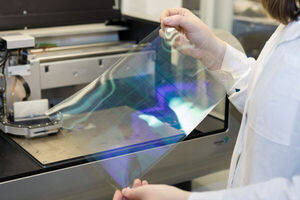
Fundamental Holography: ITMO Researchers Develop Method for Printing Holograms in Color
"Scientists from ITMO’s ChemBio Cluster developed a method for printing holograms in color in a project supported by the Russian Science Foundation. At the core of the method are volume Bragg gratings, special films with reflecting properties. The proposed technology is extremely simple and doesn’t require any costly equipment. At the same time it has the potential to help produce full color holograms even on a regular printer. This project is a result of collaboration with Krypten, a scientific production organization specializing in optical protection for banknotes, documents, and trademarks. Holography is used in many fields – for instance, in art, data storage, microscopy, as well as in sensors and optoelectronic devices." [...]
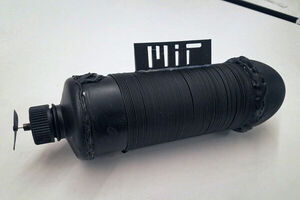
MIT engineers produce the world’s longest flexible fiber battery
"The rechargeable battery can be woven and washed, and could provide power for fiber-based electronic devices and sensors. Researchers have developed a rechargeable lithium-ion battery in the form of an ultra-long fiber that could be woven into fabrics. The battery could enable a wide variety of wearable electronic devices, and might even be used to make 3D-printed batteries in virtually any shape. The researchers envision new possibilities for self-powered communications, sensing, and computational devices that could be worn like ordinary clothing, as well as devices whose batteries could also double as structural parts. In a proof of concept, the team behind the new battery technology has produced the world’s longest flexible fiber battery, 140 meters long, to demonstrate that the material can be manufactured to arbitrarily long lengths. The work is described today in the journal Materials Today." [...]

Fast and durable batteries to come: A Promising Anode Material for Lithium-Ion Batteries
"The proposed stable anode material, made with a bio-based polymers, could unlock extremely fast battery charging for electric vehicles To overcome the slow charging times of conventional lithium-ion batteries, scientists from Japan Advanced Institute of Science and Technology have developed a new anode material that allows for ultrafast charging. Produced via a simple, environmentally sound and efficient approach involving the calcination of a bio-based polymer, this novel material also retained most of its initial capacity over thousands of cycles. The findings of this study will pave the way to fast-charging and durable batteries for electric vehicles. With the climate change concerns, an ever-increasing number of researchers are currently focusing on improving electric vehicles (EVs) to make them a more attractive alternative to conventional gas cars. The battery improvement of EVs is a key issue to attract more drives. In addition to safety, autonomy, and durability, most people want quickness in charging." [...]
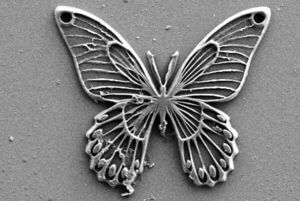
Moving objects straight off the printer
"The 'smart ink' that PhD candidate Marc del Pozo Puig developed can make printed materials change its form. It seems like science fiction: a flat object issues from the 3D printer, then starts to fold itself. Albeit in a limited way, 4D printing was already possible, but now TU/e researcher Marc del Pozo Puig has developed a smart ink that responds to all kinds of environmental stimuli, for a regular desktop 3D printer. On Wednesday December 22nd, he will obtain his doctorate at the department of Chemical Engineering and Chemistry (CEC). A flat form is placed in warm water, starts moving and within no time at all, it has become a cube. In recent years a lot of hard work has gone into developing 4D-printing, with time as the fourth dimension." [...]

New class of galactic nebulae discovered
"An international team of astronomers led by Stefan Kimeswenger from the Department of Astro and Particle Physics, together with scientific amateurs, has identified a new class of galactic nebulae. This provides an important building block in the understanding of stellar evolution and shows the importance of international collaboration between university research and community science. For the first time, scientists, starting from a discovery by scientific amateurs, have succeeded in providing evidence for a fully developed shell of a common-envelope-system (CE) – the phase of the common envelope of a binary star system. “Toward the end of their lives, normal stars inflate into red giant stars. Since a very large fraction of stars are in binary stars, this affects the evolution at the end of their lives. In close binary systems, the inflating outer part of a star merges as a common envelope around both stars." [...]
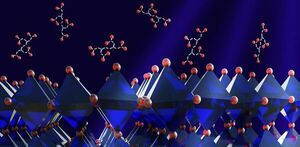
Templating approach stabilises ‘ideal’ material for alternative solar cells
"Researchers have developed a method to stabilise a promising material known as perovskite for cheap solar cells, without compromising its near-perfect performance. The researchers, from the University of Cambridge, used an organic molecule as a ‘template’ to guide perovskite films into the desired phase as they form. Their results are reported in the journal Science. Perovskite materials offer a cheaper alternative to silicon for producing optoelectronic devices such as solar cells and LEDs. There are many different perovskites, resulting from different combinations of elements, but one of the most promising to emerge in recent years is the formamidinium (FA)-based FAPbI3 crystal. The compound is thermally stable and its inherent ‘bandgap’ – the property most closely linked to the energy output of the device – is not far off ideal for photovoltaic applications." [...]
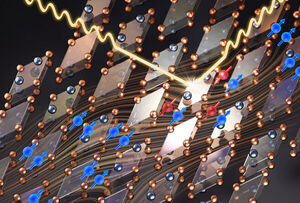
A-list candidate for fault-free quantum computing delivers surprise
"A Rice University-led study is forcing physicists to rethink superconductivity in uranium ditelluride, an A-list material in the worldwide race to create fault-tolerant quantum computers. Uranium ditelluride crystals are believed to host a rare “ spin-triplet” form of superconductivity , but puzzling experimental results published this week in Nature have upended the leading explanation of how the state of matter could arise in the material. Neutron-scattering experiments by physicists from Rice, Oak Ridge National Laboratory, the University of California, San Diego and the National High Magnetic Field Laboratory at Florida State University revealed telltale signs of antiferromagnetic spin fluctuations that were coupled to superconductivity in uranium ditelluride. Spin-triplet superconductivity has not been observed in a solid-state material, but physicists have long suspected it arises from an ordered state that is ferromagnetic. The race to find spin-triplet materials has heated up in recent years due to their potential for hosting elusive quasiparticles called Majorana fermions that could be used to make error-free quantum computers . “People have spent billions of dollars trying to search for them,” Rice study co-author Pengcheng Dai said of Majorana fermions, hypothetical quasiparticles that could be used to make topological quantum bits free from the problematic decoherence that plagues qubits in today’s quantum computers ." [...]
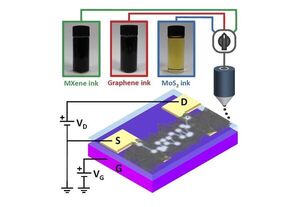
A new platform for controlled design of printed electronics with 2D materials
"Scientists have shown how electricity is transported in printed 2D materials, paving the way for design of flexible devices for healthcare and beyond. A study, published today in Nature Electronics, led by Imperial College London and Politecnico di Torino researchers reveals the physical mechanisms responsible for the transport of electricity in printed two-dimensional (2D) materials. The work identifies what properties of 2D material films need to be tweaked to make electronic devices to order, allowing rational design of a new class of high-performance printed and flexible electronics. Silicon chips are the components that power most of our electronics, from fitness trackers to smartphones. However, their rigid nature limits their use in flexible electronics. Made of single-atom-thick layers, 2D materials can be dispersed in solution and formulated into printable inks, producing ultra-thin films that are extremely flexible, semi-transparent and with novel electronic properties." [...]
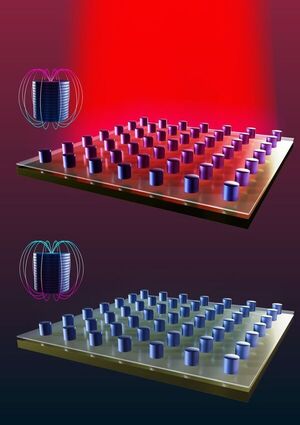
Using magnets to toggle nanolasers leads to better photonics
"Controlling nanolasers with magnets lays the groundwork for more robust optical signalling. A magnetic field can be used to switch nanolasers on and off, shows new research from Aalto University. The physics underlying this discovery paves the way for the development of optical signals that cannot be disturbed by external disruptions, leading to unprecedented robustness in signal processing. Lasers concentrate light into extremely bright beams that are useful in a variety of domains, such as broadband communication and medical diagnostics devices. About ten years ago, extremely small and fast lasers known as plasmonic nanolasers were developed. These nanolasers are potentially more power-efficient than traditional lasers, and they have been of great advantage in many fields—for example, nanolasers have increased the sensitivity of biosensors used in medical diagnostics." [...]
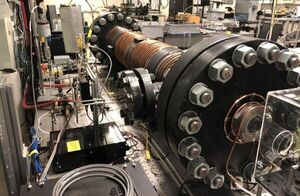
Bringing space inside the lab: Researchers replicate the climates of exoplanets to help find extraterrestrial life
"Scientists do not need to travel light-years away to chart the atmospheres of exoplanets, thanks to research happening in the Paul M. Rady Department of Mechanical Engineering with scientists at the Jet Propulsion Laboratory (JPL). Ryan Cole (PhDMechEngr’21) has developed an experiment that recreates the actual climate of planets beyond our solar system inside a 2,000 lb. instrument at Professor Greg Rieker’s lab on the University of Colorado Boulder campus. By reaching the same high-temperature and high-pressure conditions found on many exoplanets, the instrument can map the gases in their atmospheres, which could one day help humanity find life on other planets. “If we looked at Earth’s atmosphere, we would know that life is here because we see methane, carbon dioxide, all these different markers that say something is living here,” Rieker said. “We can look at the chemical signatures of exoplanets as well." [...]
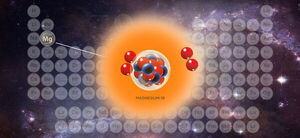
Say hello to a record-setting isotope
"Spartans joined an international team to create an isotope of magnesium that’s never been seen before In collaboration with an international team of researchers, Michigan State University has helped create the world’s lightest version, or isotope, of magnesium to date. Forged at the National Superconducting Cyclotron Laboratory at MSU, or NSCL, this isotope is so unstable, it falls apart before scientists can measure it directly. Yet this isotope that isn’t keen on existing can help researchers better understand how the atoms that define our existence are made. Led by researchers from Peking University in China, the team included scientists from Washington University in St. Louis, MSU and other institutions. “One of the big questions I’m interested in is where do the universe’s elements come from,” said Kyle Brown, an assistant professor of chemistry at the Facility for Rare Isotope Beams, or FRIB. Brown was one of the leaders of the new study, published online Dec. 22 by the journal Physical Review Letters." [...]

3D printing approaches atomic dimensions
"Oldenburg chemist Dmitry Momotenko has developed a new printing technology for tiny metallic objects. He succeeded in producing copper columns with a diameter of only 25 billionths of a meter. In recent years 3D printing, also known as additive manufacturing, has established itself as a promising new manufacturing process for a wide variety of components. Dr Dmitry Momotenko, a chemist at the University of Oldenburg, has now succeeded in fabricating ultrasmall metal objects using a new 3D printing technique. In a paper published together with a team of researchers from ETH Zurich (Switzerland) and Nanyang Technological University (Singapore) in the scientific journal Nano Letters, he reports that the technique has potential applications in microelectronics, sensor technology and battery technology. The team has developed an electrochemical technique that can be used to make objects out of copper just 25 billionths of a metre (equivalent to 25 nanometres) in diameter." [...]
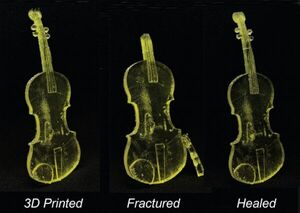
Self-healing 3D printed plastic can repair itself... using only light
"Research by UNSW academics shows that special treatment of liquid resin used in 3D printing can cause the material to mend itself if it becomes damaged. UNSW engineers have demonstrated a way to help 3D printed plastic heal itself at room temperature using only lights. Professor Cyrille Boyer and his team, Dr Nathaniel Corrigan and Mr Michael Zhang, in the UNSW School of Chemical Engineering have shown that the addition of “special powder” to the liquid resin used in the printing process can later assist with making quick and easy repairs should the material break. This can be done very simply by shining standard LED lights on the printed plastic for around one hour which causes a chemical reaction and fusion of the two broken pieces. The entire process actually makes the repaired plastic even stronger than it was before it was damaged, and it is hoped that further development and commercialisation of the technique will help to reduce chemical waste in the future. That is because broken plastic parts would not need to be discarded, or even recycled, and could be mended simply even when remaining embedded in a component including many other materials." [...]

Magnetic ‘hedgehogs’ could store big data in a small space
"New study reveals a zoo of magnetic patterns at the atomic scale Atomic-scale magnetic patterns resembling a hedgehog’s spikes could result in hard disks with massively larger capacities than today’s devices, a new study suggests. The finding could help data centers keep up with the exponentially increasing demand for video and cloud data storage. In a study published today in the journal Science, researchers at The Ohio State University used a magnetic microscope to visualize the patterns, formed in thin films of an unusual magnetic material, manganese germanide. Unlike familiar magnets such as iron, the magnetism in this material follows helices, similar to the structure of DNA. This leads to a new zoo of magnetic patterns with names such as hedgehogs, anti-hedgehogs, skyrmions and merons that can be much smaller than today’s magnetic bits. “These new magnetic patterns could be used for next-generation data storage,” said Jay Gupta, senior author of the study and a professor of physics at Ohio State." [...]

Nanodiamonds are key to efficient hydrogen purification
"Nanodiamonds may be tiny, but they can help with one of the biggest problems facing humanity today: Climate change. Hydrogen, a clean-burning fuel, leaves nothing but water when consumed. Many countries view hydrogen as a way to a zero-carbon future, but switching to a hydrogen economy requires its production to be much more affordable than it is now. In a study published in Nature Energy this month, researchers led by Kyoto University’s Institute for Integrated Cell-Material Sciences (iCeMS) describe how nanodiamond-reinforced composite membranes can purify hydrogen from its humid mixtures, making the hydrogen generation processes vastly more efficient and cost-effective. “There are several scalable methodologies to produce hydrogen, but hydrogen generally comes as humid mixtures and their purification is a challenge,” says Professor Easan Sivaniah, who led the iCeMS team. “Membrane technology allows for energy-efficient and economical separation processes." [...]
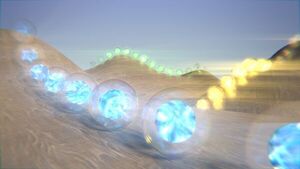
Quantum marbles in a bowl of light
"An international study shows which factors determine the speed limit for quantum computations Which factors determine how fast a quantum computer can perform its calculations? Physicists at the University of Bonn and the Technion - Israel Institute of Technology have devised an elegant experiment to answer this question. The results of the study are published in the journal Science Advances. Quantum computers are highly sophisticated machines that rely on the principles of quantum mechanics to process information. This should enable them to handle certain problems in the future that are completely unsolvable for conventional computers. But even for quantum computers, fundamental limits apply to the amount of data they can process in a given time." [...]
Semiconductors reach the quantum world
"Quantum effects in superconductors could give semiconductor technology a new twist. Researchers at the Paul Scherrer Institute PSI and Cornell University in New York State have identified a composite material that could integrate quantum devices into semiconductor technology, making electronic components significantly more powerful. They publish their findings today in the journal Science Advances. Our current electronic infrastructure is based primarily on semiconductors. This class of materials emerged around the middle of the 20th century and has been improving ever since. Currently, the most important challenges in semiconductor electronics include further improvements that would increase the bandwidth of data transmission, energy efficiency and information security." [...]

Integrated photonics meet electron microscopy
"Scientists in Switzerland and Germany have achieved efficient electron-beam modulation using integrated photonics – circuits that guide light on a chip. The experiments could lead to entirely new quantum measurement schemes in electron microscopy. The transmission electron microscope (TEM) can image molecular structures at the atomic scale by using electrons instead of light, and has revolutionized materials science and structural biology. The past decade has seen a lot of interest in combining electron microscopy with optical excitations, trying, for example, to control and manipulate the electron beam by light. But a major challenge has been the rather weak interaction of propagating electrons with photons. In a new study, researchers have successfully demonstrated extremely efficient electron beam modulation using integrated photonic microresonators." [...]
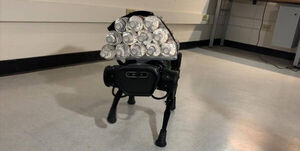
Your Next Package Could be Delivered by a Robot
"USC Viterbi researchers help four-legged robots carry heavy packages to spaces unknown. Increased package deliveries, especially in pandemic times, can put an undue stress on mail carriers and warehouse workers. But what if they could get help from some four-legged friends? Led by Assistant Professor Quan Nguyen, USC Viterbi doctoral students Mohsen Sombolestan and Yiyu Chen created a new control algorithm that allows quadruped robots to adapt to unknowns in their environment. Unlike their predecessors, these robots use an adaptive control model that can compensate for changes from the baseline, allowing them to move adeptly while carrying heavy weights and traversing sloped or uneven ground. “We have no idea how the robot will interact with obstacles or with a force, like if someone pushes or pulls on it, or adds a weight,” Sombolestan said." [...]
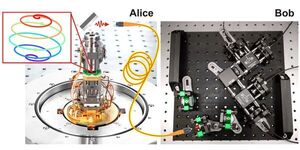
Swinging on the quantum level
"Team of researchers from Münster, Bayreuth and Berlin propose a new way of generating single photons After the “first quantum revolution” – the development of devices such as lasers and the atomic clock – the “second quantum revolution” is currently in full swing. Experts from all over the world are developing fundamentally new technologies based on quantum physics. One key application is quantum communication, where information is written and sent in light. For many applications making use of quantum effects, the light has to be in a certain state – namely a single photon state. But what is the best way of generating such single photon states? In the PRX Quantum journal, researchers from Münster, Bayreuth and Berlin have now proposed an entirely new way of preparing quantum systems in order to develop components for quantum technology." [...]
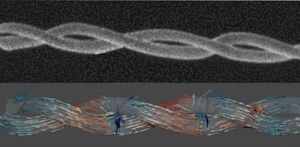
3D printed nanomagnets unveil a world of patterns in the magnetic field
"Scientists have used state-of-the-art 3D printing and microscopy to provide a new glimpse of what happens when taking magnets to three-dimensions on the nanoscale – 1000 times smaller than a human hair. "If we can control those magnetic forces on the nanoscale, we get closer to reaching the same degree of control as we have in two dimensions. This could offer new possibilities for particle trapping, imaging techniques as well as smart materials." - Claire Donnelly The international team led by Cambridge University’s Cavendish Laboratory used an advanced 3D printing technique they developed to create magnetic double helices – like the double helix of DNA – which twist around one another, combining curvature, chirality, and strong magnetic field interactions between the helices. Doing so, the scientists discovered that these magnetic double helices produce nanoscale topological textures in the magnetic field, something that had never been seen before, opening the door to the next generation of magnetic devices. The results are published in Nature Nanotechnology." [...]
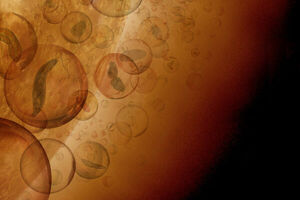
Could acid-neutralizing life-forms make habitable pockets in Venus’ clouds?
"A new study shows it’s theoretically possible. The hypothesis could be tested soon with proposed Venus-bound missions. It’s hard to imagine a more inhospitable world than our closest planetary neighbor. With an atmosphere thick with carbon dioxide, and a surface hot enough to melt lead, Venus is a scorched and suffocating wasteland where life as we know it could not survive. The planet’s clouds are similarly hostile, blanketing the planet in droplets of sulfuric acid caustic enough to burn a hole through human skin. And yet, a new study supports the longstanding idea that if life exists, it might make a home in Venus’ clouds." [...]
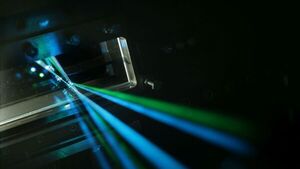
IT Security: Computer Attacks with Laser Light
"Computer systems that are physically isolated from the outside world (air-gapped) can still be attacked. This is demonstrated by IT security experts of the Karlsruhe Institute of Technology (KIT) in the LaserShark project. They show that data can be transmitted to light-emitting diodes of regular office devices using a directed laser. With this, attackers can secretly communicate with air-gapped computer systems over distances of several meters. In addition to conventional information and communication technology security, critical IT systems need to be protected optically as well. Hackers attack computers with lasers." [...]
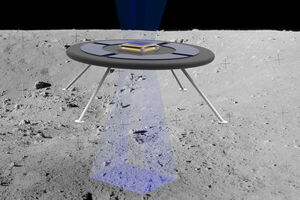
MIT engineers test an idea for a new hovering rover
"A levitating vehicle might someday explore the moon, asteroids, and other airless planetary surfaces. Aerospace engineers at MIT are testing a new concept for a hovering rover that levitates by harnessing the moon’s natural charge. Because they lack an atmosphere, the moon and other airless bodies such as asteroids can build up an electric field through direct exposure to the sun and surrounding plasma. On the moon, this surface charge is strong enough to levitate dust more than 1 meter above the ground, much the way static electricity can cause a person’s hair to stand on end. Engineers at NASA and elsewhere have recently proposed harnessing this natural surface charge to levitate a glider with wings made of Mylar, a material that naturally holds the same charge as surfaces on airless bodies. They reasoned that the similarly charged surfaces should repel each other, with a force that lofts the glider off the ground." [...]

WVU engineers creating software for aerobots to explore Venus
"Engineers at West Virginia University are propelling exploration forward by creating control software for a group of aerial robots (aerobots) that will survey the atmosphere of Venus, the second planet from the sun. According to researchers, Venus went through a climate change process that transformed it from an Earth-like environment to an inhospitable world. Studying Venus can help model the evolution of climate on Earth and serve as a reference for what can happen in the future. Guilherme Pereira and Yu Gu, associate professors in the Department of Mechanical and Aerospace Engineering, tasked with developing the software for the aerobots, which are balloon-based robotic vehicles, hope to play a pivotal role in these discoveries. Their study is supported by a $100,000 NASA Established Program to Stimulate Competitive Research. “The main goal of the project is to propose a software solution that will allow hybrid aerobots to explore the atmosphere of Venus,” Pereira said." [...]
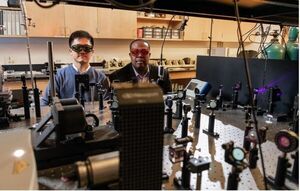
Georgia Tech Researchers Develop New Measurements For Designing Cooler Electronics
"When cell phones, electric vehicle chargers, or other electronic devices get too hot, performance degrades, and eventually overheating can cause them to shut down or fail. In order to prevent that from happening researchers are working to solve the problem of dissipating heat produced during performance. Heat that is generated in the device during operation has to flow out, ideally with little hinderance to reduce the temperature rise. Often this thermal energy must cross several dissimilar materials during the process and the interface between these materials can cause challenges by impeding heat flow. A new study from researchers at the Georgia Institute of Technology, Notre Dame, University of California Los Angeles, University of California Irvine, Oak Ridge National Laboratory, and the Naval Research Laboratory observed interfacial phonon modes which only exist at the interface between silicon (Si) and germanium (Ge). This discovery, published in the journal Nature Communications, shows experimentally that decades-old conventional theories for interfacial heat transfer are not complete and the inclusion of these phonon modes are warranted." [...]
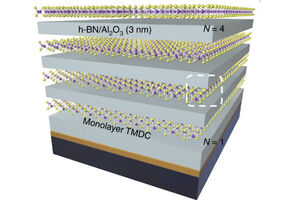
New atomically-thin material could improve efficiency of light-based tech
"Solar panels, cameras, biosensors and fiber optics are technologies that rely on photodetectors, or sensors that convert light into electricity. Photodetectors are becoming more efficient and affordable, with their component semiconductor chips decreasing in size. However, this miniaturization is pushing against limits set by current materials and manufacturing methods, forcing trade-offs between size and performance. There are many limitations of the traditional semiconductor chip manufacturing process. The chips are created by growing the semiconductor film over the top of a wafer in a way where the film’s crystalline structure is in alignment with that of the substrate wafer. This makes it difficult to transfer the film to other substrate materials, reducing its applicability." [...]
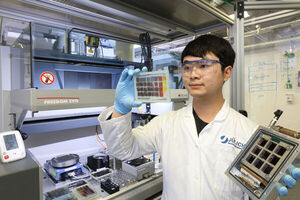
Perovskite solar cell with ultra-long stability
"Perovskites are the great hope for further increasing the efficiency of solar modules in the future. Until now, their short service life has been considered the biggest hurdle to their practical use, but this could soon change. In the current issue of the renowned journal Nature Energy, researchers from the Helmholtz Institute Erlangen-Nuremberg of the Forschungszentrum Jülich have presented a variant that stands out for its special stability. In tests at elevated temperature and illumination over 1450 hours of operation, the perovskite-based cell retained 99 percent of its initial efficiency. A characteristic feature of perovskites is a specific crystal structure. Numerous material combinations of different atoms and molecules are possible, some of which exhibit ferroelectric, superconducting or photovoltaic properties." [...]

Tuning a magnetic fluid with an electric field creates controllable dissipative patterns
"An electric field transforms an iron oxide nanoparticle suspension into a model for the emergence of complex dissipative structures Researchers at Aalto University have shown that a nanoparticle suspension can serve as a simple model for studying the formation of patterns and structures in more complicated non-equilibrium systems, such as living cells. The new system will not only be a valuable tool for studying patterning processes but also has a wide range of potential technological applications. The mixture consists of an oily liquid carrying nanoparticles of iron oxide, which become magnetized in a magnetic field. Under the right conditions, applying a voltage across this ferrofluid causes the nanoparticles to migrate, forming a concentration gradient in the mixture. For this to work, the ferrofluid has to also include docusate, a waxy chemical that can carry charge through the fluid. The researchers discovered that the presence of docusate and a voltage across the ferrofluid resulted in a separation of electric charges, with the iron oxide nanoparticles becoming negatively charged." [...]
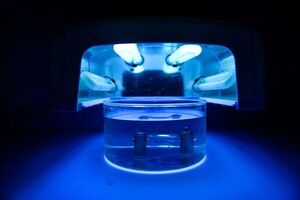
Clear Vision for Optics
"Researchers develop a faster, cheaper method to produce customized optical components for a variety of applications, including corrective eyewear, medical imaging and virtual reality Researchers have developed a way to create freeform optical components by shaping a volume of curable liquid polymer. The new method is poised to enable faster prototyping of customized optical components for a variety of applications including corrective lenses, augmented and virtual reality, autonomous vehicles, medical imaging and astronomy. Common devices such as eyeglasses or cameras rely on lenses – optical components with spherical or cylindrical surfaces, or slight deviations from such shapes. However, more advanced optical functionalities can be obtained from surfaces with complex topographies. Currently, fabricating such freeform optics is very difficult and expensive because of the specialized equipment required to mechanically process and polish their surfaces. “Our approach to making freeform optics achieves extremely smooth surfaces and can be implemented using basic equipment that can be found in most labs,” said research team leader Moran Bercovici from the Technion – Israel Institute of Technology." [...]

New materials for quantum technologies
"While conventional electronics relies on the transport of electrons, components that convey spin information alone may be many times more energy efficient. Physicists at the Technical University of Munich (TUM) and the Max Planck Institute for Solid State Research in Stuttgart have now made an important advance in the development of novel materials for such components. These materials may also be the key to quantum computers that are less susceptible to interference. Hopes ran high when the first representatives of a new class of materials – topological insulators – were discovered some 15 years ago. Researchers predicted that the unique electronic structure of these materials would give rise to special properties on their surface, such as energy-efficient information transmission, which could facilitate the development of novel electronic components in a wide range of applications. But to date, these possibilities could not be readily modified and controlled in applications." [...]
Documentação
A documentação é parte essencial do processo de aprendizagem e a Internet além de artigos interessantes de explorar também tem alguma documentação em formato PDF interessante de ler. Todos os links aqui apresentados são para conteúdo disponibilizado livremente pelo editor do livro.
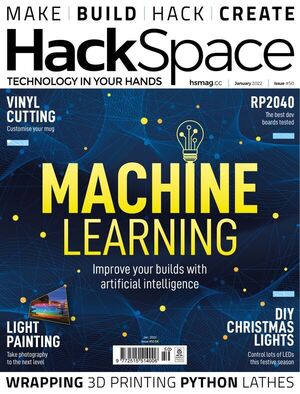
HackSpace magazine #50
"Machine learning used to be the preserve of university research departments with money to burn on high-power, high-cost kit – but not any more! Thanks to a new breed of affordable dev boards, anyone can get in on the act at pocket money prices. We’ve trawled the makersphere for the best, most creative machine learning projects to show just what can be done. The future of machine learning is awesome – and it’s here right now! - Light painting — incredible images created with a Raspberry Pi, LEDs, and the passage of time - Matt Stultz — 3D printing guru on Prusa, printing and the pandemic - Lathe gearbox — use a Raspberry Pi Pico to control the speed of a spinny thing - Christmas PCBs – get into the festive mood with custom flashing decorations" [...]
Projetos Maker
Diversos Projetos interessantes.

Tilted Twister
"Time Twister 5 is a mechanical digital clock with twisting layers. It is my first 3d printed clock. The digits are produced by twisting the layers to front one of three faces. Each layer is powered by a micro servo motor. The servo motors are controlled by an Arduino MEGA. A DS3231 Real Time Clock makes sure that the time is right." [...]

Wearable Smart Sensing Insole
"Understanding the orientation and distribution of force exerted by the feet can be extremely useful in preventing injury and assessing and improving performance in a variety of activities. Looking to improve my skiing technique and with a love of all things gadget I designed a smart pressure and angular sensing insole, designed to be worn inside your boots with minimum discomfort thanks to its small, slim design. Data from each individual sensor is fed to a mobile app wirelessly and can be used to monitor weight distribution and position in real-time or collectively at the end of a session. Use this data to know exactly what you're feet are doing and what adjustments may be necessary to improve things on your next run. Such information may be just as useful to runners and other sports alike. Some knowledge of electronics and programming of micro-controllers would be useful to complete this project." [...]

Automatic Gas Reduction System
"This is a project on automatic exhaust fan that can be triggered when gas level of a room will be increased. In this project I am going to demonstrate how we can eliminate gas from our kitchen or home using Arduino and Gas Sensor. Basically we are going to make an automatic gas reduction system. " [...]

Wings of Freedom! PCB Badge
"ATTINY13A Powered PCB Badge project based on Attack on Titan" [...]

DIY Arduino 3D Printed gear Clock
"In fact, it is not a very precise clock, but a visually interesting device. It consists of a set of gears powered by a small stepper motor. Today I will show you how to make a 3D Printed Arduino clock. In fact, it is not a precise clock, but a visually interesting device. It consists of a set of gears powered by a small stepper motor. The stepper is controlled by Arduino nano, on which is uploaded a simple sketch, and a ULN2003 motor driver board." [...]

There oughta be a WiFi Game Boy cartridge
"It took a while, but I finally managed to create my own Game Boy cartridge. With WiFi! At this point, it can only demo a simple telnet-style communication and access Wikipedia articles, but I am confident that I will showcase more in the future. For now, the interesting and surprisingly tricky part is how the thing works at all. If you just want to see the cartridge in action or want to get into all the details, I highly recommend to watch the video first as it goes through the difficulties and their respective solutions. In contrast, this article here is less visual in its explanations and mostly documents the device in detail, so unless you are already familiar with the parallel memory interface of the Game Boy, you might want to start with the overview from the video." [...]

Pico stair lights
"Using the Raspberry Pi Pico and Neopixels for animated stair lights. The beginning.. again Back when life was simple and the only people wearing masks into shops were bandits or folk in fancy dress, I made an LED stair light project using a Raspberry Pi Zero. But in the three years since that time many things in the world have changed, most notably of all being the fact that the stair lights stopped working. First the SD card mysteriously became corrupted, then after acquiring a new one and installing the software and copying over the stair light code, I was able to get it working again.. for about a week. It was clear this wasn't going to be a simple fix. I had two options, take the construction I had apart completely and try to figure out where it was going wrong or do something else." [...]

Night Time Clock
"A digital clock to help small children to differentiate day time and night time through colours. Background Small children have a tendency to wake up in the middle of the night or very early in the morning. Unfortunately at this age, they also usually haven’t learned how to tell time. So, I needed a way of helping the smol humans to know if it is still sleep time or not when they wake up. Someone told me about a clock that changes colour at night, to indicate that it is in fact night. But, instead of looking further into that and possibly buying one, I figured it would be much more fun to make one." [...]
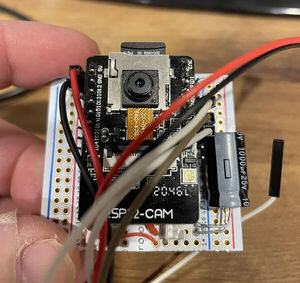
RE-LAPSE: Resin Printer Time-Lapse Recording with ESP32 CAM and Blynk
"For years I’ve been using FDM printers as my go-to for 3D printing, but recently expanded my horizons into resin printing. I like my LuzlBot Mini 2 but can never get it dialed to the point were I can achieve quality similar to resin prints. An aside to all this was the desire to record time-lapse videos – which is challenging on FDM printers as you need to integrate into the controller / g-code, and I just don’t have the patience for that at this time. For resin printers, creating a time-lapse is straight forward. Just trigger a frame capture with each layer change (or multiple layer changes if you like). Since each time a layer is cured, the UV light comes on, you simply need to watch that light with a sensor and trigger a frame capture which builds into a movie over time." [...]
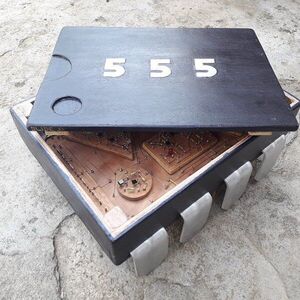
Giant 555 Timer
"A Working Replica of the classic 555 timer made using discrete components A fully functional replica of the classic 555 timer made using discrete through hole components which include only basic jellybean components like (to - 92) BJTs , 1/4Watt resistors & diodes. All the components used are salvaged from old electronics which i collect. Why I built this: I always like to make circuits from scratch and especially with discrete parts. This project is made to deeply learn each and every section of the 555 timer chip & how the IC works from inside out. This project made me learn what are current mirrors, constant current sources, sinks, long tailed pair, output stages & flip flops. Also how internal circuit of op amps and voltage comparators work." [...]

Speedlight trigger - NEW
"Device is a photo flash trigger that responds to sound, beam interruption, it works as a timer and controller for (drop) valves control. I have been doing photography of all kinds for many years and I like to experiment. 10 years ago I made a speedlight trigger that responded to sound (with classic parts NE556, LM741...). This year I decided to make a more advanced variant with an Arduino UNO controller. I decided to make the program, the electronics and the box myself. My goal was that the device does not have any mechanical control (switch, potentiometer...), that it is powered from a regular mobile phone charger or 5V powerbank and that it can work completely independently (no need for a mobile phone or external controller)." [...]
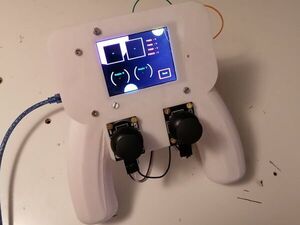
How to Make a RC Controller #2
"This project will show you how to create a RC Controller. After making hovercrafts, I decided that I would need a remote control if I wanted to use a home made drone (maybe for a future project). As a consequence, I created my own remote controller. Indeed, I had a controller before, but it was pretty useless in this case, because driving a drone certainly needs more informations, to avoid a potential crash. So, I decided to make this brand new remote controller, composed of a TFT screen, nRF24l01 radio module and arduino mega. Firstly, I needed a controller capable of displaying informations about the RC device connected to it : speed, motor thrust, angle, etc... Then, I wanted something adapted to each situation : that's why I've made different templates on this controller to ensure the remote control has at least a template for each device." [...]
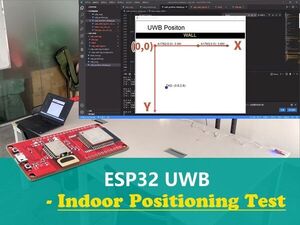
ESP32 UWB Indoor Positioning Test
"ESP32 UWB Indoor Positioning Test We made an ESP32 UWB indoor positioning test, using 2 UWB anchors and 1 UWB tag, when the tag is moving, the real-time position of the UWB tag can be graphically displayed on PC. Supplies - ESP32 UWB x3 - Power bank - 5v power supply x2 Step 1: Overview 1.1 Introduce DW1000 is the world's first single-chip wireless transceiver based on Ultra-Wideband techniques. It provides a new approach to real-time location and indoor positioning systems, location-based services, wireless sensor networks. It enables to develop cost-effective RTLS solutions with precise indoor and outdoor positioning to within 10 cm. The Makerfabs ESP32 UWB based on ESP32 and DW1000 solution, it acts like a continuously scanning radar, that precisely locks onto another device and communicates with it, thus calculating its own location, with the ESP32 WiFi/Bluetooth, it could be a solution for wireless indoor positioning. 1.2 About UWB Ultra-wideband is a technology for transmitting information across a wide bandwidth (>500 MHz)." [...]

Digital dice with IOT cheating function
"Using the M5STickC-plus as digital dice. With the possibility to read the result remotely. You will always win! Digital IOT-cheating dice The M5STickC-plus has a built-in accelerometer. And a display. With this, you can easily program digital dice that generates new values when you shake the device." [...]

WS2812B RGB lights on a 6502!
"The problem with WS2812B’s on a slow CPU When even the co-author of the FastLED library, Mark Kriegsmann, says it’s can’t be done, you know it’s not going to be easy. “The CPU would need to be at least 20X faster to support them[WS2811 based LED’s], and it isn’t. For that you want an Arduino or Teensy[…]”, as he puts it. The WS2812B protocol is very simple. Basically it’s a binary PWM signal. Said another way: A long high pulse followed by a short low period for a 1 and a short high pulse followed by a long low period for a 0, and just a long period of nothing to latch the data and turn on the LED." [...]

Where on earth is the Hall effect sensor of the ESP32?
"The ESP32 inside the M5Stack Core module has a built-in Hall effect sensor. But where exactly is this small piece located? Let's measure it. Hall sensor A Hall effect sensor has nothing to do with acoustic reverberation (German for reverb = hall) but is named after Edwin Hall and is used to measure magnetic fields. The output voltage of such a sensor is directly proportional to the strength of the magnetic field to which the sensor is exposed. Don't ask me why, but the ESP32 has an integrated Hall effect sensor." [...]

The Inspirer
"Cheer up your day with inspirational quotes & MP3 music for your desktop! The days are getting shorter, darker, and colder again - let's fight the winter blues with cheerful, positive, and inspirational quotes backed up by your personal soundtrack! This gadget sits on your desktop and showers you with its inspirational quotes. It delivers its positive energy with a retro-authentic, reassuringly non-intimidating and low-tech alphanumeric LED display. Like in the good old days. Meanwhile, press a forward or backward button (yes, it's as simple as that!" [...]

Control ESP8266 from anywhere using android app and MQTT
"In this tutorial, we will learn how to create an app for ESP8266 using drag and drop MIT App inventor. Welcome to another tutorial of the How to MQTT series. In this tutorial, we will learn to make an android application for controlling the LED and showing the sensor data (DHT11) using the MQTT protocol. We will be using MIT app inventor to create our android application. One of the main aims of the internet of things is to make connectivity with all intelligent devices. Android devices are convenient to control appliances from anywhere around the world." [...]
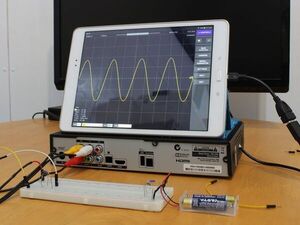
Parts-Bin Oscilloscope
"Introduction The story is simple. I decided my electronics learning journey had reached a point where an oscilloscope would be a useful tool to have. However, I'm not sure how long this electronics hobby will last and so I didn't want to spend big dollars on what might become an expensive paper weight. In fact I'm such a cheapskate that I didn't even want to spend small dollars. After some research and checking out my (sparse) parts bin and various piles of junk in the garage I figured I could build a microcontroller based scope that would be good enough for my very modest needs - without having to purchase any extra hardware. Microcontroller The first step was to choose which of my microcontroller development boards to use." [...]

WiFi Sensing via Raspberry Pi
"Use on-board WiFi of Raspberry Pi to detect motion through walls via WiFi Radio Frequencies Introduction Ever wondered whether WiFi could be used for more than just communication? This project demonstrates that WiFi signals that can be absorbed and reflected by human body can be used for detection of motion using just Raspberry Pi's on-board WiFi CSI stands for Channel State information and is extracted from OFDM signals. We will be capturing 802.11 beacons because they are ubiquitous in 5GHz and easy to control on most routers. Note: On many routers still supporting 802.11b, 2.4GHz Beacons use DSSS instead of OFDM. OpenWRT based routers have the option to disable DSSS on 2.4GHz, while most OEM's don't offer such option. Moving forward, we will be working with 5Ghz band, specifically 36/80 or 157/80 channels, as supported by default patches." [...]
Secção Videos
Videos interessantes.
That's all Folks!









